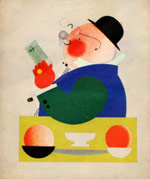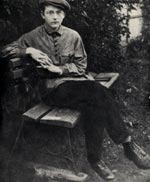
The "Holy Fool" and Shostakovich's Early Career
The Holy Fool | Chaos Instead of Music | Rehabilitation and Denunciation
The Shostakovich String Quartets | The Emerson String Quartet

|
||
|
Let's first take a look at the Russian tradition of the yurodivy before delving into Shostakovich's life. There's a kind of polarity in the Russian temperament - on one side an exuberant joyousness, and on the other a deep melancholy - both of which can sometimes reach heights of madness. I suppose that such a paradoxical emotional dissonance exists in every society and in every human being, but somehow when the Russians express joy or melancholy, the emotions seem higher and deeper than they do in the rest of us.
And there is also a third Russian characteristic - that of the yurodivy - which has been permitted to and employed by Russian artists from the 15th century on. The yurodivy is a kind of "holy fool" - the person who sees what's really going on in society and has the audacity to say it, but only in a kind of code. If there's a crooked government, the holy fool will maybe perform a weird pantomime or tell a story, one that gets everyone to laugh at first; sooner or later, the more perceptive members of the yurodivy's audience will also recognize in the fool's antics a hidden message. Stating this message in code is protection against the wrath of the authorities.
The Russian author Nikolay Gogol (1809-1852) was a wonderful example of the "holy fool". In his novels, such as his masterpi ece Dead Souls (1842), he points out the absurdity of allowing landowners to measure power by counting the number of serfs on their estates, a practice that led to listing serfs who had died generations before. Gogol, in his role of "holy fool," made his point through a viciously comic novel that evoked his readers' laughter - laughter that granted him a measure of protection from the Tsar.
Shostakovich's Early Career

|
||
|
We can see all three elements of the Russian character - the twin extremes of joy and melancholy, and the secretly communicative role of the yurodivy - in the music and person of Dmitri Shostakovich. Each aspect reflects both the enormous changes that raged through Russian society during his lifetime, as well as the extraordinary challenges he faced in following his own artistic voice under the Soviet system.
Consider this: Shostakovich was born in 1906 in St. Petersburg. By the time he started at the conservatory in 1919, it had become Petrograd Conservatory. And by the time he graduated it had become Leningrad Conservatory. And he never moved from his hometown! A sea change had occurred. The old Russian nobility and the Tsar had been thrown out, and Lenin was in power. Shostakovich, unlike his contemporaries Prokofiev and Stravinsky, was the first great Russian composer educated solely under the Soviet system.
Shostakovich first made his mark with the piano, taking lessons from his mother. He was a frail kid, nervous and high-strung, and when he entered the conservatory in 1919, just short of 16 years old, it was a kind of a haven for him. There were other musicians there with whom he could relate, and his marvelous skills at the keyboard earned him the respect of his colleagues.
The Moscow Philharmonic Orchestra, Lawrence Leighton Smith, conducting (Sheffield Lab CD-26) |
While still a part of the rarefied environment of the conservatory, Shostakovich achieved world renown with his First Symphony (1924-25), which he completed at the age of 19 as a graduation exercise. Within a couple of years, American and European orchestras were performing it - and Shostakovich was barely 21 years old! It's quite likely that this tremendous acceptance of this first symphony across the world was the main factor in his decision to pursue the life of composer rather than as a pianist.
NEXT - Chaos Instead of Music








